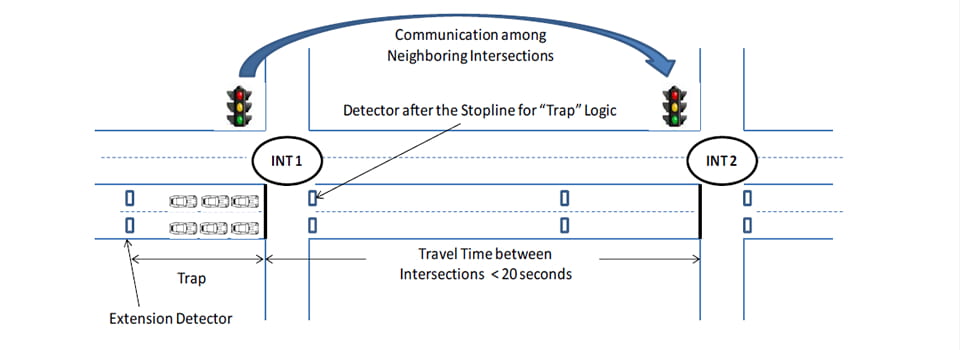Peter Furth, a Professor of Civil and Environmental Engineering at Northeastern, recently completed a project funded by the National Science Foundation to develop the concept of self-organizing traffic lights, in which each intersection’s traffic control functions independently, but also communicates with neighboring signals to create mechanisms by which intersections can synchronize to create green waves when it would be beneficial. Using this kind of logic to control traffic signals instead of the traditional logic that forces a rigid adherence to an external clock can create safer and more efficient traffic patterns with less delay for all, particularly for public transit and pedestrians.
How do self-organizing traffic lights differ from standard signals?
They use the standard logic and equipment for actuated traffic signals — also called traffic responsive signals— as a base. This method of control results in short signal cycles, which are more effective than long cycles at controlling speed and minimize delay for pedestrians and transit. It minimizes delay for side street traffic and for traffic turning off the main street. And it’s completely responsive to the current level of traffic, instead of other methods that are programmed for a certain traffic pattern and become obsolete when traffic flows change. The one weakness of standard actuated control is that for through traffic, it don’t offer green waves. With self-organizing control, the signal controllers at each intersection communicate with their neighbors, and use this input to organically organize themselves. One intersection can tell the next intersection, “I just turned green. Expect a dense bunch of 14 cars to arrive in 12 seconds.” The intersection receiving this information then uses it as input to decide whether to hold its light green. If the downstream intersection has excess capacity, and the bunch of arriving cars is big enough, dense enough, and close enough, it will synchronize with its upstream intersection, forming a green wave. The system is inherently flexible, adaptive, and self-healing (i.e, recovers easily from interruptions due to transit priority or emergency vehicles).
How can they make travel more convenient for buses, which tend to travel at a slower rate and stop more frequently than regular automotive traffic?
Buses don’t benefit from traditional green waves because, by virtue of making stops to let people get on and off, they don’t advance at the same average speed as regular traffic.
Giving buses priority at traffic signals is a means to reduce bus delay, but that means disrupting the signal cycle, and with traditional methods of signal control, that causes so much disruption that bus priority – where implemented – is severely limited. Because self-organizing logic is also self-healing, bus priority can be far more aggressive and effective, because the logic enables the signals to quickly recover and thus prevent long queues and delays to traffic movements that were shortened in favor of the bus. Also, the shorter signal cycles that self-organizing signals use means that red periods a bus might face are shorter, meaning less delay.
How has the method been tested?
Detailed traffic simulations have been conducted on urban corridors in Boston, Virginia, and Arizona with up to 17 signalized intersections. They include periods of oversaturation (overcapacity) as well as periods in which there is sufficient capacity. They include tests with and without transit signal priority. Uniform results from all those tests are that
– general traffic delay is reduced. (There may be an increase in delay to through traffic, but it is more than offset by delay reductions to crossing and turning traffic).
– transit signal priority can reduce bus delay to less than 5 s per intersection, without any increase in delay to other traffic
Presentations and Publications
Lecture about self-organizing signal (about 60 minutes): Self-Organizing Signals: A Better Framework for Transit Signal Priority. Given at Portland State University, 2015 / 03 / 13
A basic explanation of self-organizing control algorithms: Cesme, B. and P.G.Furth. “Self-Organizing Traffic Signals Using Secondary Extension and Dynamic Coordination” Transportation Research Part C: Emerging Technologies 48, 1-15, 2014.
Self-organizing control algorithms for oversaturated conditions: Cesme, B. and P.G. Furth. “Self-Organizing Control Logic for Oversaturated Arterials.” Transportation Research Record 2376, pp. 92-99, 2013.
Transit signal priority with self-organizing control: Moghimidarzi, S.B., P.G. Furth, and B. Cesme. “Predictive-Tentative Traffic Signal Priority with Self-Organizing Traffic Signal Control.” Transportation Research Record 2557, pp. 77-85, 2016.
PhD Thesis: “Self-organizing traffic signals for arterial control,” Burak Cesme, Northeastern University, March 2013.
